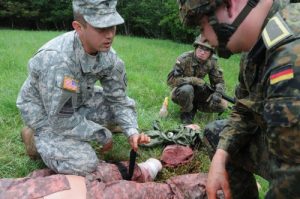GENERAL
As a combat medic on today’s battlefield, you will experience a wide variety of conditions not previously experienced. Your training has prepared you on standards that apply to the civilian emergency medical service (EMS) world that may not apply to the combat environment. These tools are a good basis for sound medical judgment; on today’s battlefield, this judgment could save the lives of your fellow soldiers. The US Army found the need to migrate away from the civilian standards and allow the combat medics to analyze situations in ways not previously thought of. These
techniques are called "tactical combat casualty care" (TC3). These techniques and factors will be discussed in the following paragraphs. Factors influencing combat casualty care include the following.
a. Enemy Fire. It may prevent the treatment of casualties and may put you at risk in providing care under enemy fire.
b. Medical Equipment Limitations. You only have what you carried in with
you in your medical aid bag.
c. A Widely Variable Evacuation Time. In the civilian community, evacuation
can be under 25 minutes; but in combat, evacuation may be delayed for several hours.
d. Tactical Considerations. Sometimes the mission will take precedence
over medical care.
e. Casualty Transportation. Transportation for evacuation may or may not
be available. Air superiority must be achieved before any air evacuation assets will be deployed. Additionally, the tactical situation will dictate when or if casualty evacuation can occur. In addition, environmental factors may prevent evacuation assets from reaching your casualty.
STAGES OF CARE
In making the transition from civilian emergency care to the tactical setting, it is useful in considering the management of casualties that occurs in a combat mission as being divided into three distinct phases.
a. Care Under Fire. Care under fire is the care rendered by the soldier medic at the scene of the injury while he and the casualty are still under effective hostile fire. Available medical equipment is limited to that carried by the individual soldier or the soldier medic in his medical aid bag.
b. Tactical Field Care. Tactical field care is the care rendered by the soldier
medic once he and the casualty are no longer under effective hostile fire. It also applies to situations in which an injury has occurred, but there is no hostile fire. Available medical equipment is still limited to that being carried into the field by medical personnel. The time needed to evacuate the casualty to a medical treatment facility (MTF) may vary considerably.
c. Combat Casualty Evacuation Care. Combat casualty evacuation
(CASEVAC) care is the care rendered once the casualty has been picked up by an aircraft, vehicle, or boat. Additional medical personnel and equipment may have been pre-staged and are available at this stage of casualty management.
As a combat medic on today’s battlefield, you will experience a wide variety of conditions not previously experienced. Your training has prepared you on standards that apply to the civilian emergency medical service (EMS) world that may not apply to the combat environment. These tools are a good basis for sound medical judgment; on today’s battlefield, this judgment could save the lives of your fellow soldiers. The US Army found the need to migrate away from the civilian standards and allow the combat medics to analyze situations in ways not previously thought of. These
techniques are called "tactical combat casualty care" (TC3). These techniques and factors will be discussed in the following paragraphs. Factors influencing combat casualty care include the following.
a. Enemy Fire. It may prevent the treatment of casualties and may put you at risk in providing care under enemy fire.
b. Medical Equipment Limitations. You only have what you carried in with
you in your medical aid bag.
c. A Widely Variable Evacuation Time. In the civilian community, evacuation
can be under 25 minutes; but in combat, evacuation may be delayed for several hours.
d. Tactical Considerations. Sometimes the mission will take precedence
over medical care.
e. Casualty Transportation. Transportation for evacuation may or may not
be available. Air superiority must be achieved before any air evacuation assets will be deployed. Additionally, the tactical situation will dictate when or if casualty evacuation can occur. In addition, environmental factors may prevent evacuation assets from reaching your casualty.
STAGES OF CARE
In making the transition from civilian emergency care to the tactical setting, it is useful in considering the management of casualties that occurs in a combat mission as being divided into three distinct phases.
a. Care Under Fire. Care under fire is the care rendered by the soldier medic at the scene of the injury while he and the casualty are still under effective hostile fire. Available medical equipment is limited to that carried by the individual soldier or the soldier medic in his medical aid bag.
b. Tactical Field Care. Tactical field care is the care rendered by the soldier
medic once he and the casualty are no longer under effective hostile fire. It also applies to situations in which an injury has occurred, but there is no hostile fire. Available medical equipment is still limited to that being carried into the field by medical personnel. The time needed to evacuate the casualty to a medical treatment facility (MTF) may vary considerably.
c. Combat Casualty Evacuation Care. Combat casualty evacuation
(CASEVAC) care is the care rendered once the casualty has been picked up by an aircraft, vehicle, or boat. Additional medical personnel and equipment may have been pre-staged and are available at this stage of casualty management.



